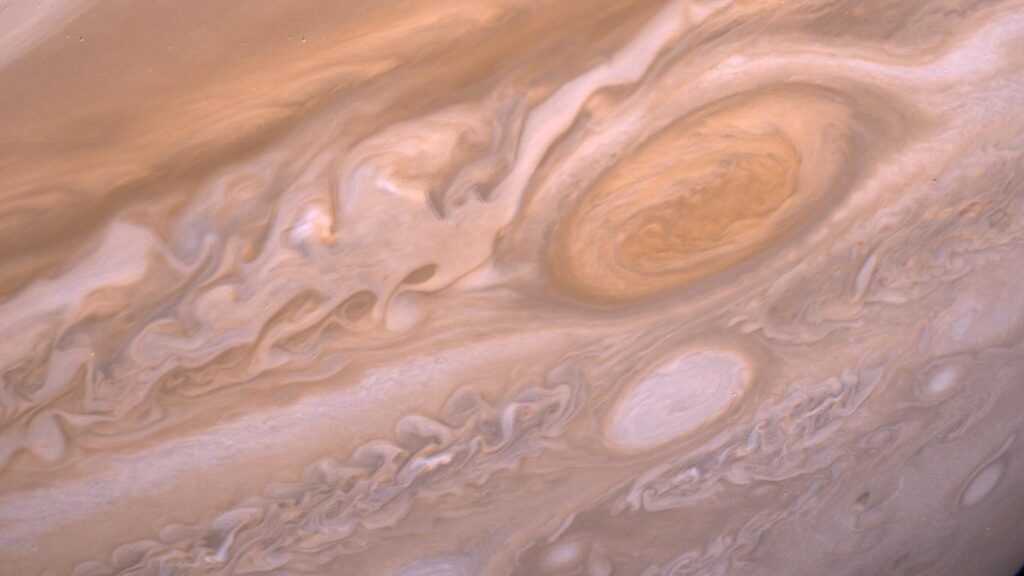Jupiter, the largest planet in our solar system, boasts an impressive diameter of over 88,800 miles, making it 11 times wider than Earth and twice as massive as all other planets combined. Recent calculations based on the orbits of Jupiter’s smallest moons suggest that the gas giant was once more than double its current size, with a magnetic field 50 times stronger. These colossal dimensions played a crucial role in shaping the solar system as we know it today. The study detailing these findings was published on May 20 in the journal Nature Astronomy.
To gain insights into Jupiter’s early stages, researchers focused on two of its smallest moons, Almathea and Thebe, which orbit the planet at slightly tilted orbits above its cloudtops.
By studying the orbital dynamics of these moons and the conservation of Jupiter’s angular momentum, scientists estimated the planet’s radius and internal state approximately 3.8 million years after the formation of the solar system. During this time, the sun was surrounded by a protoplanetary nebula that gradually formed into the planets we know today. Based on their calculations, Jupiter was likely 2 to 2.5 times larger in its early stages with a much stronger magnetic field.
“It’s remarkable that after billions of years, we can still reconstruct Jupiter’s physical state at the beginning of its existence,” said Fred Adams, a co-author of the study and a professor of physics and astronomy at the University of Michigan.
By focusing on measurable data from Jupiter’s moons and its angular momentum, the research team was able to avoid many uncertainties that typically arise in planetary formation models. This approach provides valuable insights not only into Jupiter but also into the evolution of other gas giants orbiting stars, suggesting that gas giants primarily form through core accretion.
Konstantin Batygin, a co-author of the study and a planetary science professor at Caltech, emphasized the importance of understanding the early phases of planet formation in unraveling the mysteries of our solar system’s origin.
Title: “The Enigmatic World of Deep Sea Creatures”
The deep sea is a mysterious and largely unexplored realm that covers more than half of the Earth’s surface. In this dark and inhospitable environment, a wide array of fascinating creatures thrive, each one uniquely adapted to survive in the extreme conditions of the deep ocean.
One of the most intriguing deep sea creatures is the anglerfish, a bizarre-looking fish with a bioluminescent lure dangling from its head. This lure attracts prey towards the anglerfish, which then snaps its jaws shut with lightning speed. The anglerfish’s ability to generate its own light is a rare adaptation that allows it to lure prey in the pitch-black depths of the ocean.
Another fascinating deep sea creature is the giant squid, a massive cephalopod that can grow up to 43 feet long. Giant squids have long been the stuff of legend, with sailors telling tales of encounters with these elusive creatures. Despite their size, giant squids are incredibly elusive and are rarely seen by humans.
The vampire squid is another enigmatic deep sea creature that has captured the imagination of scientists and explorers alike. Despite its fearsome name, the vampire squid is actually a gentle creature that feeds on marine snow and other small particles. Its dark, red eyes and webbed tentacles give it a sinister appearance, but in reality, the vampire squid is a harmless and fascinating denizen of the deep sea.
Deep sea creatures are not just fascinating to look at; they also play a crucial role in the health of the ocean ecosystem. Many deep sea creatures are scavengers, feeding on dead organisms that sink to the ocean floor. By consuming this organic matter, deep sea creatures help to recycle nutrients and keep the ocean ecosystem in balance.
In conclusion, the world of deep sea creatures is a mysterious and captivating one. From the bizarre anglerfish to the elusive giant squid, these creatures have evolved fascinating adaptations to survive in the extreme conditions of the deep ocean. By studying and understanding these creatures, we can gain valuable insights into the workings of the ocean ecosystem and the importance of protecting this unique and fragile environment.

